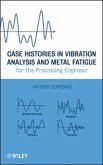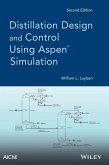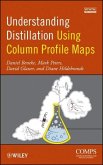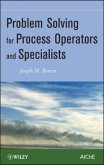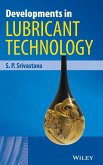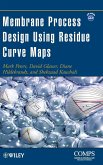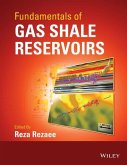William L. Luyben
Principles and Case Studies of Simultaneous Design
William L. Luyben
Principles and Case Studies of Simultaneous Design
- Gebundenes Buch
- Merkliste
- Auf die Merkliste
- Bewerten Bewerten
- Teilen
- Produkt teilen
- Produkterinnerung
- Produkterinnerung
There are many comprehensive design books, but none of them provide a significant number of detailed economic design examples of typically complex industrial processes. Most of the current design books cover a wide variety of topics associated with process design. In addition to discussing flowsheet development and equipment design, these textbooks go into a lot of detail on engineering economics and other many peripheral subjects such as written and oral skills, ethics, "green" engineering and product design. This book presents general process design principles in a concise readable form that…mehr
Andere Kunden interessierten sich auch für
![Case Histories in Vibration Analysis and Metal Fatigue for the Practicing Engineer Case Histories in Vibration Analysis and Metal Fatigue for the Practicing Engineer]() Anthony SofronasCase Histories in Vibration Analysis and Metal Fatigue for the Practicing Engineer104,99 €
Anthony SofronasCase Histories in Vibration Analysis and Metal Fatigue for the Practicing Engineer104,99 €![Distillation Simulation, 2e Distillation Simulation, 2e]() William L. LuybenDistillation Simulation, 2e163,99 €
William L. LuybenDistillation Simulation, 2e163,99 €![Understanding Distillation Using Column Profile Maps Understanding Distillation Using Column Profile Maps]() Daniel BenekeUnderstanding Distillation Using Column Profile Maps193,99 €
Daniel BenekeUnderstanding Distillation Using Column Profile Maps193,99 €![Problem Solving for Process Operators and Specialists Problem Solving for Process Operators and Specialists]() J. M. BonemProblem Solving for Process Operators and Specialists115,99 €
J. M. BonemProblem Solving for Process Operators and Specialists115,99 €![Developments in Lubricant Technology Developments in Lubricant Technology]() S. P. SrivastavaDevelopments in Lubricant Technology98,99 €
S. P. SrivastavaDevelopments in Lubricant Technology98,99 €![Membrane Process Design Using Residue Curve Maps Membrane Process Design Using Residue Curve Maps]() Mark PetersMembrane Process Design Using Residue Curve Maps183,99 €
Mark PetersMembrane Process Design Using Residue Curve Maps183,99 €![Fundamentals of Gas Shale Reservoirs Fundamentals of Gas Shale Reservoirs]() Reza RezaeeFundamentals of Gas Shale Reservoirs175,99 €
Reza RezaeeFundamentals of Gas Shale Reservoirs175,99 €-
-
-
There are many comprehensive design books, but none of them provide a significant number of detailed economic design examples of typically complex industrial processes. Most of the current design books cover a wide variety of topics associated with process design. In addition to discussing flowsheet development and equipment design, these textbooks go into a lot of detail on engineering economics and other many peripheral subjects such as written and oral skills, ethics, "green" engineering and product design. This book presents general process design principles in a concise readable form that can be easily comprehended by students and engineers when developing effective flow sheet and control structures.
Ten detailed case studies presented illustrate an in-depth and quantitative way the application of these general principles. Detailed economic steady-state designs are developed that satisfy economic criterion such as minimize total annual cost of both capital and energy or return on incremental capital investment. Complete detailed flow sheets and Aspen Plus files are provided. Then conventional PI control structures are be developed and tested for their ability to maintain product quality during disturbances. Complete Aspen Dynamics files are be provided of the dynamic simulations.
Hinweis: Dieser Artikel kann nur an eine deutsche Lieferadresse ausgeliefert werden.
Ten detailed case studies presented illustrate an in-depth and quantitative way the application of these general principles. Detailed economic steady-state designs are developed that satisfy economic criterion such as minimize total annual cost of both capital and energy or return on incremental capital investment. Complete detailed flow sheets and Aspen Plus files are provided. Then conventional PI control structures are be developed and tested for their ability to maintain product quality during disturbances. Complete Aspen Dynamics files are be provided of the dynamic simulations.
Hinweis: Dieser Artikel kann nur an eine deutsche Lieferadresse ausgeliefert werden.
Produktdetails
- Produktdetails
- Verlag: Wiley & Sons
- 1. Auflage
- Seitenzahl: 344
- Erscheinungstermin: 11. Oktober 2011
- Englisch
- Abmessung: 263mm x 184mm x 22mm
- Gewicht: 744g
- ISBN-13: 9780470927083
- ISBN-10: 0470927089
- Artikelnr.: 32734817
- Herstellerkennzeichnung
- Libri GmbH
- Europaallee 1
- 36244 Bad Hersfeld
- gpsr@libri.de
- Verlag: Wiley & Sons
- 1. Auflage
- Seitenzahl: 344
- Erscheinungstermin: 11. Oktober 2011
- Englisch
- Abmessung: 263mm x 184mm x 22mm
- Gewicht: 744g
- ISBN-13: 9780470927083
- ISBN-10: 0470927089
- Artikelnr.: 32734817
- Herstellerkennzeichnung
- Libri GmbH
- Europaallee 1
- 36244 Bad Hersfeld
- gpsr@libri.de
WILLIAM L. LUYBEN, PhD, is a professor at Lehigh University, and the author/co-author of thirteen textbooks. He has published over 250 technical papers in the area of process control and design and has supervised thirty-five PhD dissertations He has nine years of industrial experience with Exxon and DuPont.
PREFACE xv
1 INTRODUCTION 1
1.1 Overview / 1
1.2 History / 3
1.3 Books / 4
1.4 Tools / 4
Reference Textbooks / 5
2 PRINCIPLES OF REACTOR DESIGN AND CONTROL 7
2.1 Background / 7
2.2 Principles Derived from Chemistry / 8
2.2.1 Heat of Reaction / 8
2.2.2 Reversible and Irreversible Reactions / 9
2.2.3 Multiple Reactions / 10
2.3 Principles Derived from Phase of Reaction / 11
2.4 Determining Kinetic Parameters / 12
2.4.1 Thermodynamic Constraints / 12
2.4.2 Kinetic Parameters from Plant Data / 13
2.5 Principles of Reactor Heat Exchange / 13
2.5.1 Continuous Stirred-Tank Reactors / 13
2.5.2 Tubular Reactors / 14
2.5.3 Feed-Effluent Heat Exchangers / 16
2.6 Heuristic Design of Reactor/Separation Processes / 17
2.6.1 Introduction / 17
2.6.2 Process Studied / 18
2.6.3 Economic Optimization / 21
2.6.4 Other Cases / 22
2.6.5 Real Example / 27
2.7 Conclusion / 28
References / 29
3 PRINCIPLES OF DISTILLATION DESIGN AND CONTROL 31
3.1 Principles of Economic Distillation Design / 32
3.1.1 Operating Pressure / 32
3.1.2 Heuristic Optimization / 33
3.1.3 Rigorous Optimization / 33
3.1.4 Feed Preheating and Intermediate Reboilers and Condensers / 34
3.1.5 Heat Integration / 34
3.2 Principles of Distillation Control / 35
3.2.1 Single-End Control / 36
3.2.2 Dual-End Control / 38
3.2.3 Alternative Control Structures / 38
3.3 Conclusion / 39
References / 39
4 PRINCIPLES OF PLANTWIDE CONTROL 41
4.1 History / 42
4.2 Effects of Recycle / 42
4.2.1 Time Constants of Integrated Plant with Recycle / 42
4.2.2 Recycle Snowball Effect / 43
4.3 Management of Fresh Feed Streams / 45
4.3.1 Fundamentals / 45
4.3.2 Process with Two Recycles and Two Fresh Feeds / 46
4.4 Conclusion / 52
5 ECONOMIC BASIS 53
5.1 Level of Accuracy / 53
5.2 Sizing Equipment / 54
5.2.1 Vessels / 54
5.2.2 Heat Exchangers / 55
5.2.3 Compressors / 56
5.2.4 Pumps, Valves, and Piping / 56
5.3 Equipment Capital Cost / 56
5.3.1 Vessels / 56
5.3.2 Heat Exchangers / 56
5.3.3 Compressors / 57
5.4 Energy Costs / 57
5.5 Chemical Costs / 57
References / 57
6 DESIGN AND CONTROL OF THE ACETONE PROCESS VIA DEHYDROGENATION OF
ISOPROPANOL 59
6.1 Process Description / 60
6.1.1 Reaction Kinetics / 61
6.1.2 Phase Equilibrium / 62
6.2 Turton Flowsheet / 62
6.2.1 Vaporizer / 63
6.2.2 Reactor / 64
6.2.3 Heat Exchangers, Flash Tank, and Absorber / 64
6.2.4 Acetone Column C1 / 66
6.2.5 Water Column C2 / 66
6.3 Revised Flowsheet / 66
6.3.1 Effect of Absorber Pressure / 66
6.3.2 Effect of Water Solvent and Absorber Stages / 68
6.3.3 Effect of Reactor Size / 68
6.3.4 Optimum Distillation Design / 69
6.4 Economic Comparison / 69
6.5 Plantwide Control / 71
6.5.1 Control Structure / 71
6.5.2 Column Control Structure Selection / 75
6.5.3 Dynamic Performance Results / 76
6.6 Conclusion / 81
References / 81
7 DESIGN AND CONTROL OF AN AUTO-REFRIGERATED ALKYLATION PROCESS 83
7.1 Introduction / 84
7.2 Process Description / 84
7.2.1 Reaction Kinetics / 85
7.2.2 Phase Equilibrium / 85
7.2.3 Flowsheet / 86
7.2.4 Design Optimization Variables / 88
7.3 Design of Distillation Columns / 89
7.3.1 Depropanizer / 89
7.3.2 Deisobutanizer / 89
7.4 Economic Optimization of Entire Process / 91
7.4.1 Flowsheet Convergence / 91
7.4.2 Yield / 91
7.4.3 Effect of Reactor Size / 91
7.4.4 Optimum Economic Design / 93
7.5 Alternative Flowsheet / 94
7.6 Plantwide Control / 96
7.6.1 Control Structure / 96
7.6.2 Controller Tuning / 100
7.6.3 Dynamic Performance / 101
7.7 Conclusion / 103
References / 105
8 DESIGN AND CONTROL OF THE BUTYL ACETATE PROCESS 107
8.1 Introduction / 108
8.2 Chemical Kinetics and Phase Equilibrium / 108
8.2.1 Chemical Kinetics and
Chemical Equilibrium / 108
8.2.2 Vapor-Liquid Equilibrium / 110
8.3 Process Flowsheet / 112
8.3.1 Reactor / 112
8.3.2 Column C1 / 113
8.3.3 Column C2 / 113
8.3.4 Column C3 / 113
8.3.5 Flowsheet Convergence / 115
8.4 Economic Optimum Design / 117
8.4.1 Reactor Size and Temperature / 117
8.4.2 Butanol Recycle and Composition / 118
8.4.3 Distillation Column Design / 119
8.4.4 System Economics / 120
8.5 Plantwide Control / 121
8.5.1 Column C1 / 121
8.5.2 Column C2 / 122
8.5.3 Column C3 / 122
8.5.4 Plantwide Control Structure / 123
8.5.5 Dynamic Performance / 124
8.6 Conclusion / 133
References / 133
9 DESIGN AND CONTROL OF THE CUMENE PROCESS 135
9.1 Introduction / 136
9.2 Process Studied / 136
9.2.1 Reaction Kinetics / 136
9.2.2 Phase Equilibrium / 137
9.2.3 Flowsheet / 137
9.3 Economic Optimization / 140
9.3.1 Increasing Propylene Conversion / 140
9.3.2 Effects of Design Optimization Variables / 141
9.3.3 Economic Basis / 142
9.3.4 Economic Optimization Results / 143
9.4 Plantwide Control / 147
9.5 Conclusion / 158
References / 158
10 DESIGN AND CONTROL OF THE ETHYL BENZENE PROCESS 159
10.1 Introduction / 159
10.2 Process Studied / 160
10.2.1 Reaction Kinetics / 161
10.2.2 Phase Equilibrium / 162
10.2.3 Flowsheet / 163
10.3 Design of Distillation Columns / 164
10.3.1 Column Pressure Selection / 166
10.3.2 Number of Column Trays / 169
10.4 Economic Optimization of Entire Process / 169
10.5 Plantwide Control / 172
10.5.1 Distillation Column Control Structure / 172
10.5.2 Plantwide Control Structure / 173
10.5.3 Controller Tuning / 174
10.5.4 Dynamic Performance / 174
10.5.5 Modified Control Structure / 176
10.6 Conclusion / 183
References / 183
11 DESIGN AND CONTROL OF A METHANOL REACTOR/COLUMN PROCESS 185
11.1 Introduction / 185
11.2 Process Studied / 186
11.2.1 Compression and Reactor Preheating / 186
11.2.2 Reactor / 187
11.2.3 Separator, Recycle, and Vent / 187
11.2.4 Flash and Distillation / 188
11.3 Reaction Kinetics / 188
11.4 Overall and Per-Pass Conversion / 189
11.5 Phase Equilibrium / 191
11.6 Effects of Design Optimization Variables / 192
11.6.1 Economic Basis / 192
11.6.2 Effect of Pressure / 193
11.6.3 Effect of Reactor Size / 195
11.6.4 Effect of Vent/Recycle Split / 196
11.6.5 Effect of Flash-Tank Pressure / 197
11.6.6 Optimum Distillation Column Design / 198
11.7 Plantwide Control / 201
11.7.1 Control Structure / 201
11.7.2 Column Control Structure Selection / 203
11.7.3 High-Pressure Override Controller / 203
11.7.4 Dynamic Performance Results / 204
11.8 Conclusion / 209
References / 210
12 DESIGN AND CONTROL OF THE METHOXY-METHYL-HEPTANE PROCESS 211
12.1 Introduction / 211
12.2 Process Studied / 212
12.2.1 Reactor / 212
12.2.2 Column C1 / 213
12.2.3 Column C2 / 213
12.2.4 Column C3 / 213
12.3 Reaction Kinetics / 213
12.4 Phase Equilibrium / 215
12.5 Design Optimization / 215
12.5.1 Economic Basis / 216
12.5.2 Reactor Size versus Recycle Trade-Off / 216
12.6 Optimum Distillation Column Design / 220
12.6.1 Column Pressures / 220
12.6.2 Number of Stages / 220
12.6.3 Column Profiles / 222
12.7 Plantwide Control / 223
12.7.1 Control Structure / 225
12.7.2 Dynamic Performance Results / 227
12.8 Conclusion / 230
References / 231
13 DESIGN AND CONTROL OF A METHYL ACETATE PROCESS USING CARBONYLATION OF
DIMETHYL ETHER 233
13.1 Introduction / 233
13.2 Dehydration Section / 234
13.2.1 Process Description of Dehydration Section / 234
13.2.2 Dehydration Kinetics / 235
13.2.3 Alternative Flowsheets / 236
13.2.4 Optimization of Three Flowsheets / 240
13.3 Carbonylation Section / 245
13.3.1 Process Description / 246
13.3.2 Carbonylation Kinetics / 247
13.3.3 Effect of Parameters / 248
13.3.4 Flowsheet Convergence / 250
13.3.5 Optimization / 251
13.4 Plantwide Control / 255
13.4.1 Control Structure / 255
13.4.2 Dynamic Performance / 261
13.5 Conclusion / 262
References / 262
14 DESIGN AND CONTROL OF THE MONO-ISOPROPYL AMINE PROCESS 263
14.1 Introduction / 263
14.2 Process Studied / 264
14.2.1 Reaction Kinetics / 264
14.2.2 Phase Equilibrium / 265
14.2.3 Flowsheet / 266
14.3 Economic Optimization / 268
14.3.1 Design Optimization Variables / 268
14.3.2 Optimization Results / 269
14.4 Plantwide Control / 270
14.4.1 Dynamic Model Sizing / 271
14.4.2 Distillation Column Control Structures / 272
14.4.3 Plantwide Control Structure / 276
14.5 Conclusion / 289
References / 290
15 DESIGN AND CONTROL OF THE STYRENE PROCESS 291
15.1 Introduction / 292
15.2 Kinetics and Phase Equilibrium / 293
15.2.1 Reaction Kinetics / 293
15.2.2 Phase Equilibrium / 294
15.3 Vasudevan et al. Flowsheet / 295
15.3.1 Reactors / 295
15.3.2 Condenser and Decanter / 295
15.3.3 Product Column C1 / 296
15.3.4 Recycle Column C2 / 298
15.4 Effects of Design Optimization Variables / 298
15.4.1 Effect of Process Steam / 298
15.4.2 Effect of Reactor Inlet Temperature / 301
15.4.3 Effect of Reactor Size / 302
15.4.4 Optimum Distillation Column Design / 303
15.4.5 Number of Reactors / 304
15.4.6 Reoptimization / 304
15.4.7 Other Improvements / 305
15.5 Proposed Design / 305
15.6 Plantwide Control / 306
15.6.1 Control Structure / 306
15.6.2 Column Control Structure Selection / 310
15.6.3 Dynamic Performance Results / 312
15.7 Conclusion / 317
References / 317
NOMENCLATURE 319
INDEX 321
1 INTRODUCTION 1
1.1 Overview / 1
1.2 History / 3
1.3 Books / 4
1.4 Tools / 4
Reference Textbooks / 5
2 PRINCIPLES OF REACTOR DESIGN AND CONTROL 7
2.1 Background / 7
2.2 Principles Derived from Chemistry / 8
2.2.1 Heat of Reaction / 8
2.2.2 Reversible and Irreversible Reactions / 9
2.2.3 Multiple Reactions / 10
2.3 Principles Derived from Phase of Reaction / 11
2.4 Determining Kinetic Parameters / 12
2.4.1 Thermodynamic Constraints / 12
2.4.2 Kinetic Parameters from Plant Data / 13
2.5 Principles of Reactor Heat Exchange / 13
2.5.1 Continuous Stirred-Tank Reactors / 13
2.5.2 Tubular Reactors / 14
2.5.3 Feed-Effluent Heat Exchangers / 16
2.6 Heuristic Design of Reactor/Separation Processes / 17
2.6.1 Introduction / 17
2.6.2 Process Studied / 18
2.6.3 Economic Optimization / 21
2.6.4 Other Cases / 22
2.6.5 Real Example / 27
2.7 Conclusion / 28
References / 29
3 PRINCIPLES OF DISTILLATION DESIGN AND CONTROL 31
3.1 Principles of Economic Distillation Design / 32
3.1.1 Operating Pressure / 32
3.1.2 Heuristic Optimization / 33
3.1.3 Rigorous Optimization / 33
3.1.4 Feed Preheating and Intermediate Reboilers and Condensers / 34
3.1.5 Heat Integration / 34
3.2 Principles of Distillation Control / 35
3.2.1 Single-End Control / 36
3.2.2 Dual-End Control / 38
3.2.3 Alternative Control Structures / 38
3.3 Conclusion / 39
References / 39
4 PRINCIPLES OF PLANTWIDE CONTROL 41
4.1 History / 42
4.2 Effects of Recycle / 42
4.2.1 Time Constants of Integrated Plant with Recycle / 42
4.2.2 Recycle Snowball Effect / 43
4.3 Management of Fresh Feed Streams / 45
4.3.1 Fundamentals / 45
4.3.2 Process with Two Recycles and Two Fresh Feeds / 46
4.4 Conclusion / 52
5 ECONOMIC BASIS 53
5.1 Level of Accuracy / 53
5.2 Sizing Equipment / 54
5.2.1 Vessels / 54
5.2.2 Heat Exchangers / 55
5.2.3 Compressors / 56
5.2.4 Pumps, Valves, and Piping / 56
5.3 Equipment Capital Cost / 56
5.3.1 Vessels / 56
5.3.2 Heat Exchangers / 56
5.3.3 Compressors / 57
5.4 Energy Costs / 57
5.5 Chemical Costs / 57
References / 57
6 DESIGN AND CONTROL OF THE ACETONE PROCESS VIA DEHYDROGENATION OF
ISOPROPANOL 59
6.1 Process Description / 60
6.1.1 Reaction Kinetics / 61
6.1.2 Phase Equilibrium / 62
6.2 Turton Flowsheet / 62
6.2.1 Vaporizer / 63
6.2.2 Reactor / 64
6.2.3 Heat Exchangers, Flash Tank, and Absorber / 64
6.2.4 Acetone Column C1 / 66
6.2.5 Water Column C2 / 66
6.3 Revised Flowsheet / 66
6.3.1 Effect of Absorber Pressure / 66
6.3.2 Effect of Water Solvent and Absorber Stages / 68
6.3.3 Effect of Reactor Size / 68
6.3.4 Optimum Distillation Design / 69
6.4 Economic Comparison / 69
6.5 Plantwide Control / 71
6.5.1 Control Structure / 71
6.5.2 Column Control Structure Selection / 75
6.5.3 Dynamic Performance Results / 76
6.6 Conclusion / 81
References / 81
7 DESIGN AND CONTROL OF AN AUTO-REFRIGERATED ALKYLATION PROCESS 83
7.1 Introduction / 84
7.2 Process Description / 84
7.2.1 Reaction Kinetics / 85
7.2.2 Phase Equilibrium / 85
7.2.3 Flowsheet / 86
7.2.4 Design Optimization Variables / 88
7.3 Design of Distillation Columns / 89
7.3.1 Depropanizer / 89
7.3.2 Deisobutanizer / 89
7.4 Economic Optimization of Entire Process / 91
7.4.1 Flowsheet Convergence / 91
7.4.2 Yield / 91
7.4.3 Effect of Reactor Size / 91
7.4.4 Optimum Economic Design / 93
7.5 Alternative Flowsheet / 94
7.6 Plantwide Control / 96
7.6.1 Control Structure / 96
7.6.2 Controller Tuning / 100
7.6.3 Dynamic Performance / 101
7.7 Conclusion / 103
References / 105
8 DESIGN AND CONTROL OF THE BUTYL ACETATE PROCESS 107
8.1 Introduction / 108
8.2 Chemical Kinetics and Phase Equilibrium / 108
8.2.1 Chemical Kinetics and
Chemical Equilibrium / 108
8.2.2 Vapor-Liquid Equilibrium / 110
8.3 Process Flowsheet / 112
8.3.1 Reactor / 112
8.3.2 Column C1 / 113
8.3.3 Column C2 / 113
8.3.4 Column C3 / 113
8.3.5 Flowsheet Convergence / 115
8.4 Economic Optimum Design / 117
8.4.1 Reactor Size and Temperature / 117
8.4.2 Butanol Recycle and Composition / 118
8.4.3 Distillation Column Design / 119
8.4.4 System Economics / 120
8.5 Plantwide Control / 121
8.5.1 Column C1 / 121
8.5.2 Column C2 / 122
8.5.3 Column C3 / 122
8.5.4 Plantwide Control Structure / 123
8.5.5 Dynamic Performance / 124
8.6 Conclusion / 133
References / 133
9 DESIGN AND CONTROL OF THE CUMENE PROCESS 135
9.1 Introduction / 136
9.2 Process Studied / 136
9.2.1 Reaction Kinetics / 136
9.2.2 Phase Equilibrium / 137
9.2.3 Flowsheet / 137
9.3 Economic Optimization / 140
9.3.1 Increasing Propylene Conversion / 140
9.3.2 Effects of Design Optimization Variables / 141
9.3.3 Economic Basis / 142
9.3.4 Economic Optimization Results / 143
9.4 Plantwide Control / 147
9.5 Conclusion / 158
References / 158
10 DESIGN AND CONTROL OF THE ETHYL BENZENE PROCESS 159
10.1 Introduction / 159
10.2 Process Studied / 160
10.2.1 Reaction Kinetics / 161
10.2.2 Phase Equilibrium / 162
10.2.3 Flowsheet / 163
10.3 Design of Distillation Columns / 164
10.3.1 Column Pressure Selection / 166
10.3.2 Number of Column Trays / 169
10.4 Economic Optimization of Entire Process / 169
10.5 Plantwide Control / 172
10.5.1 Distillation Column Control Structure / 172
10.5.2 Plantwide Control Structure / 173
10.5.3 Controller Tuning / 174
10.5.4 Dynamic Performance / 174
10.5.5 Modified Control Structure / 176
10.6 Conclusion / 183
References / 183
11 DESIGN AND CONTROL OF A METHANOL REACTOR/COLUMN PROCESS 185
11.1 Introduction / 185
11.2 Process Studied / 186
11.2.1 Compression and Reactor Preheating / 186
11.2.2 Reactor / 187
11.2.3 Separator, Recycle, and Vent / 187
11.2.4 Flash and Distillation / 188
11.3 Reaction Kinetics / 188
11.4 Overall and Per-Pass Conversion / 189
11.5 Phase Equilibrium / 191
11.6 Effects of Design Optimization Variables / 192
11.6.1 Economic Basis / 192
11.6.2 Effect of Pressure / 193
11.6.3 Effect of Reactor Size / 195
11.6.4 Effect of Vent/Recycle Split / 196
11.6.5 Effect of Flash-Tank Pressure / 197
11.6.6 Optimum Distillation Column Design / 198
11.7 Plantwide Control / 201
11.7.1 Control Structure / 201
11.7.2 Column Control Structure Selection / 203
11.7.3 High-Pressure Override Controller / 203
11.7.4 Dynamic Performance Results / 204
11.8 Conclusion / 209
References / 210
12 DESIGN AND CONTROL OF THE METHOXY-METHYL-HEPTANE PROCESS 211
12.1 Introduction / 211
12.2 Process Studied / 212
12.2.1 Reactor / 212
12.2.2 Column C1 / 213
12.2.3 Column C2 / 213
12.2.4 Column C3 / 213
12.3 Reaction Kinetics / 213
12.4 Phase Equilibrium / 215
12.5 Design Optimization / 215
12.5.1 Economic Basis / 216
12.5.2 Reactor Size versus Recycle Trade-Off / 216
12.6 Optimum Distillation Column Design / 220
12.6.1 Column Pressures / 220
12.6.2 Number of Stages / 220
12.6.3 Column Profiles / 222
12.7 Plantwide Control / 223
12.7.1 Control Structure / 225
12.7.2 Dynamic Performance Results / 227
12.8 Conclusion / 230
References / 231
13 DESIGN AND CONTROL OF A METHYL ACETATE PROCESS USING CARBONYLATION OF
DIMETHYL ETHER 233
13.1 Introduction / 233
13.2 Dehydration Section / 234
13.2.1 Process Description of Dehydration Section / 234
13.2.2 Dehydration Kinetics / 235
13.2.3 Alternative Flowsheets / 236
13.2.4 Optimization of Three Flowsheets / 240
13.3 Carbonylation Section / 245
13.3.1 Process Description / 246
13.3.2 Carbonylation Kinetics / 247
13.3.3 Effect of Parameters / 248
13.3.4 Flowsheet Convergence / 250
13.3.5 Optimization / 251
13.4 Plantwide Control / 255
13.4.1 Control Structure / 255
13.4.2 Dynamic Performance / 261
13.5 Conclusion / 262
References / 262
14 DESIGN AND CONTROL OF THE MONO-ISOPROPYL AMINE PROCESS 263
14.1 Introduction / 263
14.2 Process Studied / 264
14.2.1 Reaction Kinetics / 264
14.2.2 Phase Equilibrium / 265
14.2.3 Flowsheet / 266
14.3 Economic Optimization / 268
14.3.1 Design Optimization Variables / 268
14.3.2 Optimization Results / 269
14.4 Plantwide Control / 270
14.4.1 Dynamic Model Sizing / 271
14.4.2 Distillation Column Control Structures / 272
14.4.3 Plantwide Control Structure / 276
14.5 Conclusion / 289
References / 290
15 DESIGN AND CONTROL OF THE STYRENE PROCESS 291
15.1 Introduction / 292
15.2 Kinetics and Phase Equilibrium / 293
15.2.1 Reaction Kinetics / 293
15.2.2 Phase Equilibrium / 294
15.3 Vasudevan et al. Flowsheet / 295
15.3.1 Reactors / 295
15.3.2 Condenser and Decanter / 295
15.3.3 Product Column C1 / 296
15.3.4 Recycle Column C2 / 298
15.4 Effects of Design Optimization Variables / 298
15.4.1 Effect of Process Steam / 298
15.4.2 Effect of Reactor Inlet Temperature / 301
15.4.3 Effect of Reactor Size / 302
15.4.4 Optimum Distillation Column Design / 303
15.4.5 Number of Reactors / 304
15.4.6 Reoptimization / 304
15.4.7 Other Improvements / 305
15.5 Proposed Design / 305
15.6 Plantwide Control / 306
15.6.1 Control Structure / 306
15.6.2 Column Control Structure Selection / 310
15.6.3 Dynamic Performance Results / 312
15.7 Conclusion / 317
References / 317
NOMENCLATURE 319
INDEX 321
PREFACE xv
1 INTRODUCTION 1
1.1 Overview / 1
1.2 History / 3
1.3 Books / 4
1.4 Tools / 4
Reference Textbooks / 5
2 PRINCIPLES OF REACTOR DESIGN AND CONTROL 7
2.1 Background / 7
2.2 Principles Derived from Chemistry / 8
2.2.1 Heat of Reaction / 8
2.2.2 Reversible and Irreversible Reactions / 9
2.2.3 Multiple Reactions / 10
2.3 Principles Derived from Phase of Reaction / 11
2.4 Determining Kinetic Parameters / 12
2.4.1 Thermodynamic Constraints / 12
2.4.2 Kinetic Parameters from Plant Data / 13
2.5 Principles of Reactor Heat Exchange / 13
2.5.1 Continuous Stirred-Tank Reactors / 13
2.5.2 Tubular Reactors / 14
2.5.3 Feed-Effluent Heat Exchangers / 16
2.6 Heuristic Design of Reactor/Separation Processes / 17
2.6.1 Introduction / 17
2.6.2 Process Studied / 18
2.6.3 Economic Optimization / 21
2.6.4 Other Cases / 22
2.6.5 Real Example / 27
2.7 Conclusion / 28
References / 29
3 PRINCIPLES OF DISTILLATION DESIGN AND CONTROL 31
3.1 Principles of Economic Distillation Design / 32
3.1.1 Operating Pressure / 32
3.1.2 Heuristic Optimization / 33
3.1.3 Rigorous Optimization / 33
3.1.4 Feed Preheating and Intermediate Reboilers and Condensers / 34
3.1.5 Heat Integration / 34
3.2 Principles of Distillation Control / 35
3.2.1 Single-End Control / 36
3.2.2 Dual-End Control / 38
3.2.3 Alternative Control Structures / 38
3.3 Conclusion / 39
References / 39
4 PRINCIPLES OF PLANTWIDE CONTROL 41
4.1 History / 42
4.2 Effects of Recycle / 42
4.2.1 Time Constants of Integrated Plant with Recycle / 42
4.2.2 Recycle Snowball Effect / 43
4.3 Management of Fresh Feed Streams / 45
4.3.1 Fundamentals / 45
4.3.2 Process with Two Recycles and Two Fresh Feeds / 46
4.4 Conclusion / 52
5 ECONOMIC BASIS 53
5.1 Level of Accuracy / 53
5.2 Sizing Equipment / 54
5.2.1 Vessels / 54
5.2.2 Heat Exchangers / 55
5.2.3 Compressors / 56
5.2.4 Pumps, Valves, and Piping / 56
5.3 Equipment Capital Cost / 56
5.3.1 Vessels / 56
5.3.2 Heat Exchangers / 56
5.3.3 Compressors / 57
5.4 Energy Costs / 57
5.5 Chemical Costs / 57
References / 57
6 DESIGN AND CONTROL OF THE ACETONE PROCESS VIA DEHYDROGENATION OF
ISOPROPANOL 59
6.1 Process Description / 60
6.1.1 Reaction Kinetics / 61
6.1.2 Phase Equilibrium / 62
6.2 Turton Flowsheet / 62
6.2.1 Vaporizer / 63
6.2.2 Reactor / 64
6.2.3 Heat Exchangers, Flash Tank, and Absorber / 64
6.2.4 Acetone Column C1 / 66
6.2.5 Water Column C2 / 66
6.3 Revised Flowsheet / 66
6.3.1 Effect of Absorber Pressure / 66
6.3.2 Effect of Water Solvent and Absorber Stages / 68
6.3.3 Effect of Reactor Size / 68
6.3.4 Optimum Distillation Design / 69
6.4 Economic Comparison / 69
6.5 Plantwide Control / 71
6.5.1 Control Structure / 71
6.5.2 Column Control Structure Selection / 75
6.5.3 Dynamic Performance Results / 76
6.6 Conclusion / 81
References / 81
7 DESIGN AND CONTROL OF AN AUTO-REFRIGERATED ALKYLATION PROCESS 83
7.1 Introduction / 84
7.2 Process Description / 84
7.2.1 Reaction Kinetics / 85
7.2.2 Phase Equilibrium / 85
7.2.3 Flowsheet / 86
7.2.4 Design Optimization Variables / 88
7.3 Design of Distillation Columns / 89
7.3.1 Depropanizer / 89
7.3.2 Deisobutanizer / 89
7.4 Economic Optimization of Entire Process / 91
7.4.1 Flowsheet Convergence / 91
7.4.2 Yield / 91
7.4.3 Effect of Reactor Size / 91
7.4.4 Optimum Economic Design / 93
7.5 Alternative Flowsheet / 94
7.6 Plantwide Control / 96
7.6.1 Control Structure / 96
7.6.2 Controller Tuning / 100
7.6.3 Dynamic Performance / 101
7.7 Conclusion / 103
References / 105
8 DESIGN AND CONTROL OF THE BUTYL ACETATE PROCESS 107
8.1 Introduction / 108
8.2 Chemical Kinetics and Phase Equilibrium / 108
8.2.1 Chemical Kinetics and
Chemical Equilibrium / 108
8.2.2 Vapor-Liquid Equilibrium / 110
8.3 Process Flowsheet / 112
8.3.1 Reactor / 112
8.3.2 Column C1 / 113
8.3.3 Column C2 / 113
8.3.4 Column C3 / 113
8.3.5 Flowsheet Convergence / 115
8.4 Economic Optimum Design / 117
8.4.1 Reactor Size and Temperature / 117
8.4.2 Butanol Recycle and Composition / 118
8.4.3 Distillation Column Design / 119
8.4.4 System Economics / 120
8.5 Plantwide Control / 121
8.5.1 Column C1 / 121
8.5.2 Column C2 / 122
8.5.3 Column C3 / 122
8.5.4 Plantwide Control Structure / 123
8.5.5 Dynamic Performance / 124
8.6 Conclusion / 133
References / 133
9 DESIGN AND CONTROL OF THE CUMENE PROCESS 135
9.1 Introduction / 136
9.2 Process Studied / 136
9.2.1 Reaction Kinetics / 136
9.2.2 Phase Equilibrium / 137
9.2.3 Flowsheet / 137
9.3 Economic Optimization / 140
9.3.1 Increasing Propylene Conversion / 140
9.3.2 Effects of Design Optimization Variables / 141
9.3.3 Economic Basis / 142
9.3.4 Economic Optimization Results / 143
9.4 Plantwide Control / 147
9.5 Conclusion / 158
References / 158
10 DESIGN AND CONTROL OF THE ETHYL BENZENE PROCESS 159
10.1 Introduction / 159
10.2 Process Studied / 160
10.2.1 Reaction Kinetics / 161
10.2.2 Phase Equilibrium / 162
10.2.3 Flowsheet / 163
10.3 Design of Distillation Columns / 164
10.3.1 Column Pressure Selection / 166
10.3.2 Number of Column Trays / 169
10.4 Economic Optimization of Entire Process / 169
10.5 Plantwide Control / 172
10.5.1 Distillation Column Control Structure / 172
10.5.2 Plantwide Control Structure / 173
10.5.3 Controller Tuning / 174
10.5.4 Dynamic Performance / 174
10.5.5 Modified Control Structure / 176
10.6 Conclusion / 183
References / 183
11 DESIGN AND CONTROL OF A METHANOL REACTOR/COLUMN PROCESS 185
11.1 Introduction / 185
11.2 Process Studied / 186
11.2.1 Compression and Reactor Preheating / 186
11.2.2 Reactor / 187
11.2.3 Separator, Recycle, and Vent / 187
11.2.4 Flash and Distillation / 188
11.3 Reaction Kinetics / 188
11.4 Overall and Per-Pass Conversion / 189
11.5 Phase Equilibrium / 191
11.6 Effects of Design Optimization Variables / 192
11.6.1 Economic Basis / 192
11.6.2 Effect of Pressure / 193
11.6.3 Effect of Reactor Size / 195
11.6.4 Effect of Vent/Recycle Split / 196
11.6.5 Effect of Flash-Tank Pressure / 197
11.6.6 Optimum Distillation Column Design / 198
11.7 Plantwide Control / 201
11.7.1 Control Structure / 201
11.7.2 Column Control Structure Selection / 203
11.7.3 High-Pressure Override Controller / 203
11.7.4 Dynamic Performance Results / 204
11.8 Conclusion / 209
References / 210
12 DESIGN AND CONTROL OF THE METHOXY-METHYL-HEPTANE PROCESS 211
12.1 Introduction / 211
12.2 Process Studied / 212
12.2.1 Reactor / 212
12.2.2 Column C1 / 213
12.2.3 Column C2 / 213
12.2.4 Column C3 / 213
12.3 Reaction Kinetics / 213
12.4 Phase Equilibrium / 215
12.5 Design Optimization / 215
12.5.1 Economic Basis / 216
12.5.2 Reactor Size versus Recycle Trade-Off / 216
12.6 Optimum Distillation Column Design / 220
12.6.1 Column Pressures / 220
12.6.2 Number of Stages / 220
12.6.3 Column Profiles / 222
12.7 Plantwide Control / 223
12.7.1 Control Structure / 225
12.7.2 Dynamic Performance Results / 227
12.8 Conclusion / 230
References / 231
13 DESIGN AND CONTROL OF A METHYL ACETATE PROCESS USING CARBONYLATION OF
DIMETHYL ETHER 233
13.1 Introduction / 233
13.2 Dehydration Section / 234
13.2.1 Process Description of Dehydration Section / 234
13.2.2 Dehydration Kinetics / 235
13.2.3 Alternative Flowsheets / 236
13.2.4 Optimization of Three Flowsheets / 240
13.3 Carbonylation Section / 245
13.3.1 Process Description / 246
13.3.2 Carbonylation Kinetics / 247
13.3.3 Effect of Parameters / 248
13.3.4 Flowsheet Convergence / 250
13.3.5 Optimization / 251
13.4 Plantwide Control / 255
13.4.1 Control Structure / 255
13.4.2 Dynamic Performance / 261
13.5 Conclusion / 262
References / 262
14 DESIGN AND CONTROL OF THE MONO-ISOPROPYL AMINE PROCESS 263
14.1 Introduction / 263
14.2 Process Studied / 264
14.2.1 Reaction Kinetics / 264
14.2.2 Phase Equilibrium / 265
14.2.3 Flowsheet / 266
14.3 Economic Optimization / 268
14.3.1 Design Optimization Variables / 268
14.3.2 Optimization Results / 269
14.4 Plantwide Control / 270
14.4.1 Dynamic Model Sizing / 271
14.4.2 Distillation Column Control Structures / 272
14.4.3 Plantwide Control Structure / 276
14.5 Conclusion / 289
References / 290
15 DESIGN AND CONTROL OF THE STYRENE PROCESS 291
15.1 Introduction / 292
15.2 Kinetics and Phase Equilibrium / 293
15.2.1 Reaction Kinetics / 293
15.2.2 Phase Equilibrium / 294
15.3 Vasudevan et al. Flowsheet / 295
15.3.1 Reactors / 295
15.3.2 Condenser and Decanter / 295
15.3.3 Product Column C1 / 296
15.3.4 Recycle Column C2 / 298
15.4 Effects of Design Optimization Variables / 298
15.4.1 Effect of Process Steam / 298
15.4.2 Effect of Reactor Inlet Temperature / 301
15.4.3 Effect of Reactor Size / 302
15.4.4 Optimum Distillation Column Design / 303
15.4.5 Number of Reactors / 304
15.4.6 Reoptimization / 304
15.4.7 Other Improvements / 305
15.5 Proposed Design / 305
15.6 Plantwide Control / 306
15.6.1 Control Structure / 306
15.6.2 Column Control Structure Selection / 310
15.6.3 Dynamic Performance Results / 312
15.7 Conclusion / 317
References / 317
NOMENCLATURE 319
INDEX 321
1 INTRODUCTION 1
1.1 Overview / 1
1.2 History / 3
1.3 Books / 4
1.4 Tools / 4
Reference Textbooks / 5
2 PRINCIPLES OF REACTOR DESIGN AND CONTROL 7
2.1 Background / 7
2.2 Principles Derived from Chemistry / 8
2.2.1 Heat of Reaction / 8
2.2.2 Reversible and Irreversible Reactions / 9
2.2.3 Multiple Reactions / 10
2.3 Principles Derived from Phase of Reaction / 11
2.4 Determining Kinetic Parameters / 12
2.4.1 Thermodynamic Constraints / 12
2.4.2 Kinetic Parameters from Plant Data / 13
2.5 Principles of Reactor Heat Exchange / 13
2.5.1 Continuous Stirred-Tank Reactors / 13
2.5.2 Tubular Reactors / 14
2.5.3 Feed-Effluent Heat Exchangers / 16
2.6 Heuristic Design of Reactor/Separation Processes / 17
2.6.1 Introduction / 17
2.6.2 Process Studied / 18
2.6.3 Economic Optimization / 21
2.6.4 Other Cases / 22
2.6.5 Real Example / 27
2.7 Conclusion / 28
References / 29
3 PRINCIPLES OF DISTILLATION DESIGN AND CONTROL 31
3.1 Principles of Economic Distillation Design / 32
3.1.1 Operating Pressure / 32
3.1.2 Heuristic Optimization / 33
3.1.3 Rigorous Optimization / 33
3.1.4 Feed Preheating and Intermediate Reboilers and Condensers / 34
3.1.5 Heat Integration / 34
3.2 Principles of Distillation Control / 35
3.2.1 Single-End Control / 36
3.2.2 Dual-End Control / 38
3.2.3 Alternative Control Structures / 38
3.3 Conclusion / 39
References / 39
4 PRINCIPLES OF PLANTWIDE CONTROL 41
4.1 History / 42
4.2 Effects of Recycle / 42
4.2.1 Time Constants of Integrated Plant with Recycle / 42
4.2.2 Recycle Snowball Effect / 43
4.3 Management of Fresh Feed Streams / 45
4.3.1 Fundamentals / 45
4.3.2 Process with Two Recycles and Two Fresh Feeds / 46
4.4 Conclusion / 52
5 ECONOMIC BASIS 53
5.1 Level of Accuracy / 53
5.2 Sizing Equipment / 54
5.2.1 Vessels / 54
5.2.2 Heat Exchangers / 55
5.2.3 Compressors / 56
5.2.4 Pumps, Valves, and Piping / 56
5.3 Equipment Capital Cost / 56
5.3.1 Vessels / 56
5.3.2 Heat Exchangers / 56
5.3.3 Compressors / 57
5.4 Energy Costs / 57
5.5 Chemical Costs / 57
References / 57
6 DESIGN AND CONTROL OF THE ACETONE PROCESS VIA DEHYDROGENATION OF
ISOPROPANOL 59
6.1 Process Description / 60
6.1.1 Reaction Kinetics / 61
6.1.2 Phase Equilibrium / 62
6.2 Turton Flowsheet / 62
6.2.1 Vaporizer / 63
6.2.2 Reactor / 64
6.2.3 Heat Exchangers, Flash Tank, and Absorber / 64
6.2.4 Acetone Column C1 / 66
6.2.5 Water Column C2 / 66
6.3 Revised Flowsheet / 66
6.3.1 Effect of Absorber Pressure / 66
6.3.2 Effect of Water Solvent and Absorber Stages / 68
6.3.3 Effect of Reactor Size / 68
6.3.4 Optimum Distillation Design / 69
6.4 Economic Comparison / 69
6.5 Plantwide Control / 71
6.5.1 Control Structure / 71
6.5.2 Column Control Structure Selection / 75
6.5.3 Dynamic Performance Results / 76
6.6 Conclusion / 81
References / 81
7 DESIGN AND CONTROL OF AN AUTO-REFRIGERATED ALKYLATION PROCESS 83
7.1 Introduction / 84
7.2 Process Description / 84
7.2.1 Reaction Kinetics / 85
7.2.2 Phase Equilibrium / 85
7.2.3 Flowsheet / 86
7.2.4 Design Optimization Variables / 88
7.3 Design of Distillation Columns / 89
7.3.1 Depropanizer / 89
7.3.2 Deisobutanizer / 89
7.4 Economic Optimization of Entire Process / 91
7.4.1 Flowsheet Convergence / 91
7.4.2 Yield / 91
7.4.3 Effect of Reactor Size / 91
7.4.4 Optimum Economic Design / 93
7.5 Alternative Flowsheet / 94
7.6 Plantwide Control / 96
7.6.1 Control Structure / 96
7.6.2 Controller Tuning / 100
7.6.3 Dynamic Performance / 101
7.7 Conclusion / 103
References / 105
8 DESIGN AND CONTROL OF THE BUTYL ACETATE PROCESS 107
8.1 Introduction / 108
8.2 Chemical Kinetics and Phase Equilibrium / 108
8.2.1 Chemical Kinetics and
Chemical Equilibrium / 108
8.2.2 Vapor-Liquid Equilibrium / 110
8.3 Process Flowsheet / 112
8.3.1 Reactor / 112
8.3.2 Column C1 / 113
8.3.3 Column C2 / 113
8.3.4 Column C3 / 113
8.3.5 Flowsheet Convergence / 115
8.4 Economic Optimum Design / 117
8.4.1 Reactor Size and Temperature / 117
8.4.2 Butanol Recycle and Composition / 118
8.4.3 Distillation Column Design / 119
8.4.4 System Economics / 120
8.5 Plantwide Control / 121
8.5.1 Column C1 / 121
8.5.2 Column C2 / 122
8.5.3 Column C3 / 122
8.5.4 Plantwide Control Structure / 123
8.5.5 Dynamic Performance / 124
8.6 Conclusion / 133
References / 133
9 DESIGN AND CONTROL OF THE CUMENE PROCESS 135
9.1 Introduction / 136
9.2 Process Studied / 136
9.2.1 Reaction Kinetics / 136
9.2.2 Phase Equilibrium / 137
9.2.3 Flowsheet / 137
9.3 Economic Optimization / 140
9.3.1 Increasing Propylene Conversion / 140
9.3.2 Effects of Design Optimization Variables / 141
9.3.3 Economic Basis / 142
9.3.4 Economic Optimization Results / 143
9.4 Plantwide Control / 147
9.5 Conclusion / 158
References / 158
10 DESIGN AND CONTROL OF THE ETHYL BENZENE PROCESS 159
10.1 Introduction / 159
10.2 Process Studied / 160
10.2.1 Reaction Kinetics / 161
10.2.2 Phase Equilibrium / 162
10.2.3 Flowsheet / 163
10.3 Design of Distillation Columns / 164
10.3.1 Column Pressure Selection / 166
10.3.2 Number of Column Trays / 169
10.4 Economic Optimization of Entire Process / 169
10.5 Plantwide Control / 172
10.5.1 Distillation Column Control Structure / 172
10.5.2 Plantwide Control Structure / 173
10.5.3 Controller Tuning / 174
10.5.4 Dynamic Performance / 174
10.5.5 Modified Control Structure / 176
10.6 Conclusion / 183
References / 183
11 DESIGN AND CONTROL OF A METHANOL REACTOR/COLUMN PROCESS 185
11.1 Introduction / 185
11.2 Process Studied / 186
11.2.1 Compression and Reactor Preheating / 186
11.2.2 Reactor / 187
11.2.3 Separator, Recycle, and Vent / 187
11.2.4 Flash and Distillation / 188
11.3 Reaction Kinetics / 188
11.4 Overall and Per-Pass Conversion / 189
11.5 Phase Equilibrium / 191
11.6 Effects of Design Optimization Variables / 192
11.6.1 Economic Basis / 192
11.6.2 Effect of Pressure / 193
11.6.3 Effect of Reactor Size / 195
11.6.4 Effect of Vent/Recycle Split / 196
11.6.5 Effect of Flash-Tank Pressure / 197
11.6.6 Optimum Distillation Column Design / 198
11.7 Plantwide Control / 201
11.7.1 Control Structure / 201
11.7.2 Column Control Structure Selection / 203
11.7.3 High-Pressure Override Controller / 203
11.7.4 Dynamic Performance Results / 204
11.8 Conclusion / 209
References / 210
12 DESIGN AND CONTROL OF THE METHOXY-METHYL-HEPTANE PROCESS 211
12.1 Introduction / 211
12.2 Process Studied / 212
12.2.1 Reactor / 212
12.2.2 Column C1 / 213
12.2.3 Column C2 / 213
12.2.4 Column C3 / 213
12.3 Reaction Kinetics / 213
12.4 Phase Equilibrium / 215
12.5 Design Optimization / 215
12.5.1 Economic Basis / 216
12.5.2 Reactor Size versus Recycle Trade-Off / 216
12.6 Optimum Distillation Column Design / 220
12.6.1 Column Pressures / 220
12.6.2 Number of Stages / 220
12.6.3 Column Profiles / 222
12.7 Plantwide Control / 223
12.7.1 Control Structure / 225
12.7.2 Dynamic Performance Results / 227
12.8 Conclusion / 230
References / 231
13 DESIGN AND CONTROL OF A METHYL ACETATE PROCESS USING CARBONYLATION OF
DIMETHYL ETHER 233
13.1 Introduction / 233
13.2 Dehydration Section / 234
13.2.1 Process Description of Dehydration Section / 234
13.2.2 Dehydration Kinetics / 235
13.2.3 Alternative Flowsheets / 236
13.2.4 Optimization of Three Flowsheets / 240
13.3 Carbonylation Section / 245
13.3.1 Process Description / 246
13.3.2 Carbonylation Kinetics / 247
13.3.3 Effect of Parameters / 248
13.3.4 Flowsheet Convergence / 250
13.3.5 Optimization / 251
13.4 Plantwide Control / 255
13.4.1 Control Structure / 255
13.4.2 Dynamic Performance / 261
13.5 Conclusion / 262
References / 262
14 DESIGN AND CONTROL OF THE MONO-ISOPROPYL AMINE PROCESS 263
14.1 Introduction / 263
14.2 Process Studied / 264
14.2.1 Reaction Kinetics / 264
14.2.2 Phase Equilibrium / 265
14.2.3 Flowsheet / 266
14.3 Economic Optimization / 268
14.3.1 Design Optimization Variables / 268
14.3.2 Optimization Results / 269
14.4 Plantwide Control / 270
14.4.1 Dynamic Model Sizing / 271
14.4.2 Distillation Column Control Structures / 272
14.4.3 Plantwide Control Structure / 276
14.5 Conclusion / 289
References / 290
15 DESIGN AND CONTROL OF THE STYRENE PROCESS 291
15.1 Introduction / 292
15.2 Kinetics and Phase Equilibrium / 293
15.2.1 Reaction Kinetics / 293
15.2.2 Phase Equilibrium / 294
15.3 Vasudevan et al. Flowsheet / 295
15.3.1 Reactors / 295
15.3.2 Condenser and Decanter / 295
15.3.3 Product Column C1 / 296
15.3.4 Recycle Column C2 / 298
15.4 Effects of Design Optimization Variables / 298
15.4.1 Effect of Process Steam / 298
15.4.2 Effect of Reactor Inlet Temperature / 301
15.4.3 Effect of Reactor Size / 302
15.4.4 Optimum Distillation Column Design / 303
15.4.5 Number of Reactors / 304
15.4.6 Reoptimization / 304
15.4.7 Other Improvements / 305
15.5 Proposed Design / 305
15.6 Plantwide Control / 306
15.6.1 Control Structure / 306
15.6.2 Column Control Structure Selection / 310
15.6.3 Dynamic Performance Results / 312
15.7 Conclusion / 317
References / 317
NOMENCLATURE 319
INDEX 321


